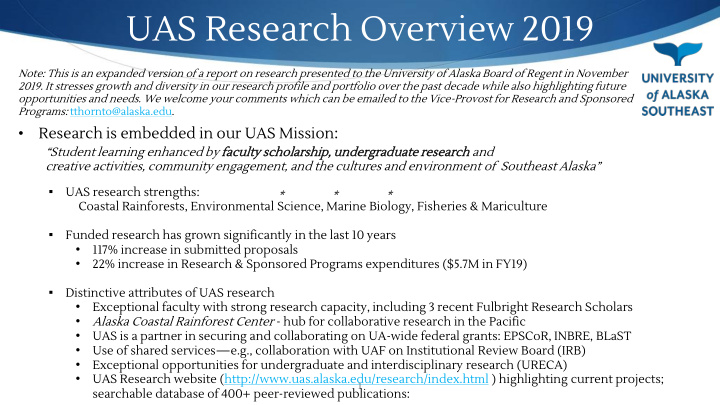



UAS Research Overview 2019 Note: This is an expanded version of a report on research presented to the University of Alaska Board of Regent in November 2019. It stresses growth and diversity in our research profile and portfolio over the past decade while also highlighting future opportunities and needs. We welcome your comments which can be emailed to the Vice-Provost for Research and Sponsored Programs: tthornto@alaska.edu. Research is embedded in our UAS Mission: • “Student learning enhanced by faculty ty schola larsh rship ip, , undergr grad aduate te research ch and creative activities, community engagement, and the cultures and environment of Southeast Alaska ” ▪ UAS research strengths: * * * Coastal Rainforests, Environmental Science, Marine Biology, Fisheries & Mariculture ▪ Funded research has grown significantly in the last 10 years • 117% increase in submitted proposals • 22% increase in Research & Sponsored Programs expenditures ($5.7M in FY19) ▪ Distinctive attributes of UAS research • Exceptional faculty with strong research capacity, including 3 recent Fulbright Research Scholars • Alaska Coastal Rainforest Center - hub for collaborative research in the Pacific • UAS is a partner in securing and collaborating on UA-wide federal grants: EPSCoR, INBRE, BLaST • Use of shared services — e.g., collaboration with UAF on Institutional Review Board (IRB) • Exceptional opportunities for undergraduate and interdisciplinary research (URECA) • UAS Research website (http://www.uas.alaska.edu/research/index.html ) highlighting current projects; 1 searchable database of 400+ peer-reviewed publications:
Alaska Coastal Rainforest Center The Alaska Coastal Rainforest Center builds partnerships and catalyzes collaborative ecological, economic, and social research in the north Pacific coastal temperate rainforest to support vibrant and resilient communities and ecosystems. Land Ecosystems Coastal Linkages • Yellow-cedar decline ecology and salvage • Coastal Rainforest Margins Research Network logging opportunities • Alaska EPSCoR Fire & Ice Coastal Margins Team • Alpine vegetation change monitoring • Partnerships with UAA and UAF • Wildlife habitat change assessment Glacier Dynamics Ocean Resources • Understanding glacial lake outburst floods at Suicide Basin and beyond • Ocean acidification monitoring via the ferry Columbia • Monitoring and modeling harmful algal Stream Dynamics blooms and PSP events • Stream chemistry and food web modeling Funding Partners: • Extreme weather events and stream flow for AK DOT, AK DGGS, AK DNR, AK DCCED, ADF&G infrastructure planning and design USGS, USFS, NOAA NMFS, NOAA NWS, NOAA PMEL, NIH 2 NSF, AOOS, Tula Foundation
UAS Collaborations • One Health biomedical research : Spatiotemporal variability of water quality impacts in Southeast Alaska • Undergraduate research opportunities in health & science: Biosensor for Shellfish Toxins ( BLaST/NIH) • Building research capacity: EPSCoR, Phase 4 (NSF) — Forest Ecology, Coastal Margins, and Microbiology (new position) • Southeast Oceanographic data analysis : NASA Space Grant and summer Kayak Oceanography course. • Alaska Native and Community Partnerships : Sealaska Heritage Institute (herring populations); Sitka Tribe (toxicology); Sitka Sound Science Center (WhaleFest) 3
Research Spotlight: Ocean Health and Coastal Resources Climat mate-dri driven ven changes nges to t the ocean that aff ffect fi fish sheries ries and human an healt lth Ocean Acidification Monitoring via the Ferry M/V Columbia Partners: Alaska DOT, Alaska Marine Highway System • Alaska Ocean Observing System • NOAA Pacific Marine Environmental Lab • • Tula Foundation Monitoring and Modeling Harmful Algal Blooms Partners: NOAA • • NIH/BLAST program, UAF Sitka Tribe of Alaska • 4
Research Spotlight: Ocean Health and Coastal Resources Usi sing ng innovati vative ve tools s to under erst stand and chang nging ng ecosystems ems Using eDNA to quantify salmon runs and Identifying factors limiting coho stocks Partners: NMFS Alaska Science Center • Oregon State University • • Auke Creek Salmon Weir Auke Creek Weir, NOAA Modeling extreme climate events for infrastructure planning – atmospheric rivers & drought Donovan Bell, BS Partners: Biology • Alaska Department of Transportation & Public Facilities Alaska Division of Geological and Geophysical Surveys • National Weather Service • • US Geological Survey 5 Using drone technology for research
Research Spotlight: Marine Mammals in Coastal Ecosystems Sea Otters ters, , Ocean ean Carb rbon & Cl Clima mate te • Chang nge • Relationship of Sea otters, urchins, & kelp More kelp = more carbon stored • Marine conservation is an innovative strategy for climate change mitigation in Alaska Sustainab ainabil ility ity of Whale le Watch ching ing • • A rapidly growing industry in Juneau: ~$35M/yr • Humpback whales respond negatively to whale- watch vessels • Sustainable management practices will preserve the long-term health of the industry NMFS Permit #14122
Research Spotlight: Safe Scent — Guiding Marine Life Away from Danger Award winner in the 2019 Arctic Innovation Competition Professor Jan Straley, UAS Sitka 7
Opportunities to Enhance UAS Research • Enhance Alaska Coastal Rainforest Center to boost UAS environmental research capacity • Increase Post-Doctoral fellows, Visiting Research Faculty program: -Short-term funded opportunities for research faculty • Expand and formalize UA-wide research networks: -Opportunities in mariculture, renewable energy, toxicology, sustainability science • Construct UAS Auke Bay Integrated Science Facility to consolidate research labs & faculty on UAS campus -Adds efficiencies and creates more compact footprint • Looking forward: Consider adding new one- year Master’s degree with research or practicum components linked to university projects and state needs 8
Recommend
More recommend